Tumor Response and Its Impact on Treatment Failure in Rectal Cancer: Does Intensity of Neoadjuvant Treatment Matter?
Simple Summary
Abstract
1. Introduction
2. Materials and Methods
3. Results
4. Discussion
5. Conclusions
Supplementary Materials
Author Contributions
Funding
Institutional Review Board Statement
Informed Consent Statement
Data Availability Statement
Conflicts of Interest
References
- Sauer, R.; Becker, H.; Hohenberger, W.; Rodel, C.; Wittekind, C.; Fietkau, R.; Martus, P.; Tschmelitsch, J.; Hager, E.; Hess, C.F.; et al. Preoperative versus postoperative chemoradiotherapy for rectal cancer. N. Engl. J. Med. 2004, 351, 1731–1740. [Google Scholar] [CrossRef] [PubMed]
- Swedish Rectal Cancer, T.; Cedermark, B.; Dahlberg, M.; Glimelius, B.; Pahlman, L.; Rutqvist, L.E.; Wilking, N. Improved survival with preoperative radiotherapy in resectable rectal cancer. N. Engl. J. Med. 1997, 336, 980–987. [Google Scholar] [CrossRef]
- Kapiteijn, E.; Marijnen, C.A.; Nagtegaal, I.D.; Putter, H.; Steup, W.H.; Wiggers, T.; Rutten, H.J.; Pahlman, L.; Glimelius, B.; van Krieken, J.H.; et al. Preoperative radiotherapy combined with total mesorectal excision for resectable rectal cancer. N. Engl. J. Med. 2001, 345, 638–646. [Google Scholar] [CrossRef] [PubMed]
- Diefenhardt, M.; Ludmir, E.B.; Hofheinz, R.D.; Ghadimi, M.; Minsky, B.D.; Rodel, C.; Fokas, E. Association of Treatment Adherence With Oncologic Outcomes for Patients With Rectal Cancer: A Post Hoc Analysis of the CAO/ARO/AIO-04 Phase 3 Randomized Clinical Trial. JAMA Oncol. 2020, 6, 1416–1421. [Google Scholar] [CrossRef]
- Bahadoer, R.R.; Dijkstra, E.A.; van Etten, B.; Marijnen, C.A.M.; Putter, H.; Kranenbarg, E.M.; Roodvoets, A.G.H.; Nagtegaal, I.D.; Beets-Tan, R.G.H.; Blomqvist, L.K.; et al. Short-course radiotherapy followed by chemotherapy before total mesorectal excision (TME) versus preoperative chemoradiotherapy, TME, and optional adjuvant chemotherapy in locally advanced rectal cancer (RAPIDO): A randomised, open-label, phase 3 trial. Lancet Oncol. 2021, 22, 29–42. [Google Scholar] [CrossRef]
- Conroy, T.; Bosset, J.F.; Etienne, P.L.; Rio, E.; Francois, E.; Mesgouez-Nebout, N.; Vendrely, V.; Artignan, X.; Bouche, O.; Gargot, D.; et al. Neoadjuvant chemotherapy with FOLFIRINOX and preoperative chemoradiotherapy for patients with locally advanced rectal cancer (UNICANCER-PRODIGE 23): A multicentre, randomised, open-label, phase 3 trial. Lancet Oncol. 2021, 22, 702–715. [Google Scholar] [CrossRef]
- Conroy, T.; Etienne, P.-L.; Rio, E.; Evesque, L.; Mesgouez-Nebout, N.; Vendrely, V.; Artignan, X.; Bouche, O.; Boileve, A.; Delaye, M.; et al. Total neoadjuvant therapy with mFOLFIRINOX versus preoperative chemoradiation in patients with locally advanced rectal cancer: 7-year results of PRODIGE 23 phase III trial, a UNICANCER GI trial. J. Clin. Oncol. 2023, 41, LBA3504. [Google Scholar] [CrossRef]
- Carvalho, C.; Glynne-Jones, R. Challenges behind proving efficacy of adjuvant chemotherapy after preoperative chemoradiation for rectal cancer. Lancet Oncol. 2017, 18, e354–e363. [Google Scholar] [CrossRef]
- Fokas, E.; Liersch, T.; Fietkau, R.; Hohenberger, W.; Hess, C.; Becker, H.; Sauer, R.; Wittekind, C.; Rodel, C. Downstage migration after neoadjuvant chemoradiotherapy for rectal cancer: The reverse of the Will Rogers phenomenon? Cancer 2015, 121, 1724–1727. [Google Scholar] [CrossRef]
- Sauer, R.; Liersch, T.; Merkel, S.; Fietkau, R.; Hohenberger, W.; Hess, C.; Becker, H.; Raab, H.R.; Villanueva, M.T.; Witzigmann, H.; et al. Preoperative versus postoperative chemoradiotherapy for locally advanced rectal cancer: Results of the German CAO/ARO/AIO-94 randomized phase III trial after a median follow-up of 11 years. J. Clin. Oncol. 2012, 30, 1926–1933. [Google Scholar] [CrossRef]
- Rodel, C.; Liersch, T.; Becker, H.; Fietkau, R.; Hohenberger, W.; Hothorn, T.; Graeven, U.; Arnold, D.; Lang-Welzenbach, M.; Raab, H.R.; et al. Preoperative chemoradiotherapy and postoperative chemotherapy with fluorouracil and oxaliplatin versus fluorouracil alone in locally advanced rectal cancer: Initial results of the German CAO/ARO/AIO-04 randomised phase 3 trial. Lancet Oncol. 2012, 13, 679–687. [Google Scholar] [CrossRef] [PubMed]
- Rodel, C.; Graeven, U.; Fietkau, R.; Hohenberger, W.; Hothorn, T.; Arnold, D.; Hofheinz, R.D.; Ghadimi, M.; Wolff, H.A.; Lang-Welzenbach, M.; et al. Oxaliplatin added to fluorouracil-based preoperative chemoradiotherapy and postoperative chemotherapy of locally advanced rectal cancer (the German CAO/ARO/AIO-04 study): Final results of the multicentre, open-label, randomised, phase 3 trial. Lancet Oncol. 2015, 16, 979–989. [Google Scholar] [CrossRef] [PubMed]
- Fokas, E.; Allgauer, M.; Polat, B.; Klautke, G.; Grabenbauer, G.G.; Fietkau, R.; Kuhnt, T.; Staib, L.; Brunner, T.; Grosu, A.L.; et al. Randomized Phase II Trial of Chemoradiotherapy Plus Induction or Consolidation Chemotherapy as Total Neoadjuvant Therapy for Locally Advanced Rectal Cancer: CAO/ARO/AIO-12. J. Clin. Oncol. 2019, 37, 3212–3222. [Google Scholar] [CrossRef] [PubMed]
- Fokas, E.; Schlenska-Lange, A.; Polat, B.; Klautke, G.; Grabenbauer, G.G.; Fietkau, R.; Kuhnt, T.; Staib, L.; Brunner, T.; Grosu, A.L.; et al. Chemoradiotherapy Plus Induction or Consolidation Chemotherapy as Total Neoadjuvant Therapy for Patients With Locally Advanced Rectal Cancer: Long-term Results of the CAO/ARO/AIO-12 Randomized Clinical Trial. JAMA Oncol. 2022, 8, e215445. [Google Scholar] [CrossRef] [PubMed]
- Dworak, O.; Keilholz, L.; Hoffmann, A. Pathological features of rectal cancer after preoperative radiochemotherapy. Int. J. Color. Dis. 1997, 12, 19–23. [Google Scholar] [CrossRef]
- Fokas, E.; Strobel, P.; Fietkau, R.; Ghadimi, M.; Liersch, T.; Grabenbauer, G.G.; Hartmann, A.; Kaufmann, M.; Sauer, R.; Graeven, U.; et al. Tumor Regression Grading After Preoperative Chemoradiotherapy as a Prognostic Factor and Individual-Level Surrogate for Disease-Free Survival in Rectal Cancer. J. Natl. Cancer Inst. 2017, 109, djx095. [Google Scholar] [CrossRef]
- Diefenhardt, M.; Martin, D.; Fleischmann, M.; Hofheinz, R.D.; Ghadimi, M.; Rodel, C.; Fokas, E. Overall Survival After Treatment Failure Among Patients With Rectal Cancer. JAMA Netw. Open 2023, 6, e2340256. [Google Scholar] [CrossRef]
- Viechtbauer, W. The metafor Package A Meta-Analysis Package for R. Available online: https://www.metafor-project.org/doku.php/metafor (accessed on 13 June 2024).
- Gray, R.J. A Class of K-Sample Tests for Comparing the Cumulative Incidence of a Competing Risk. Ann. Stat. 1988, 16, 1141–1154. [Google Scholar] [CrossRef]
- Nahhas, R.W. Introduction to Regression Methods for Public Health Using R. Available online: https://bookdown.org/rwnahhas/RMPH/ (accessed on 27 October 2024).
- Probst, C.P.; Becerra, A.Z.; Aquina, C.T.; Tejani, M.A.; Wexner, S.D.; Garcia-Aguilar, J.; Remzi, F.H.; Dietz, D.W.; Monson, J.R.; Fleming, F.J.; et al. Extended Intervals after Neoadjuvant Therapy in Locally Advanced Rectal Cancer: The Key to Improved Tumor Response and Potential Organ Preservation. J. Am. Coll. Surg. 2015, 221, 430–440. [Google Scholar] [CrossRef]
- Dijkstra, E.A.; Zwart, W.H.; Nilsson, P.J.; Putter, H.; Roodvoets, A.G.H.; Meershoek-Klein Kranenbarg, E.; Frodin, J.E.; Nygren, P.; Ostergaard, L.; Kersten, C.; et al. The value of post-operative chemotherapy after chemoradiotherapy in patients with high-risk locally advanced rectal cancer-results from the RAPIDO trial. ESMO Open 2023, 8, 101158. [Google Scholar] [CrossRef]
- Collette, L.; Bosset, J.F.; den Dulk, M.; Nguyen, F.; Mineur, L.; Maingon, P.; Radosevic-Jelic, L.; Pierart, M.; Calais, G.; European Organisation for, R.; et al. Patients with curative resection of cT3-4 rectal cancer after preoperative radiotherapy or radiochemotherapy: Does anybody benefit from adjuvant fluorouracil-based chemotherapy? A trial of the European Organisation for Research and Treatment of Cancer Radiation Oncology Group. J. Clin. Oncol. 2007, 25, 4379–4386. [Google Scholar] [CrossRef] [PubMed]
- NCCN. NCCN Guidelines Version 4.2024 Rectal Cancer. Available online: https://www.nccn.org/professionals/physician_gls/pdf/rectal.pdf (accessed on 25 August 2024).
- van Etten, B.; Glimelius, B.; Hospers, G.A.P.; Marijnen, C.A.M.; Nilsson, P.J.; van de Velde, C.J.H. RAPIDO Rectal cancer And Pre-operative Induction therapy followed by Dedicated Operation. Available online: https://dccg.nl/files/RAPIDO_protocol_3.1_signed_20160318_0.pdf (accessed on 27 October 2024).
- Vogl, T.J.; Pereira, P.L.; Helmberger, T.; Schreyer, A.G.; Schmiegel, W.; Fischer, S.; Herzog, C. Updated S3 Guidelines—Diagnosis and Treatment of Colorectal Carcinoma: Relevance for Radiological Diagnosis and Intervention. Rofo 2019, 191, 298–310. [Google Scholar] [CrossRef] [PubMed]
- Scheele, J.; Schmidt, S.A.; Tenzer, S.; Henne-Bruns, D.; Kornmann, M. Overstaging: A Challenge in Rectal Cancer Treatment. Visc. Med. 2018, 34, 301–306. [Google Scholar] [CrossRef] [PubMed]
- Detering, R.; van Oostendorp, S.E.; Meyer, V.M.; van Dieren, S.; Bos, A.; Dekker, J.W.T.; Reerink, O.; van Waesberghe, J.; Marijnen, C.A.M.; Moons, L.M.G.; et al. MRI cT1-2 rectal cancer staging accuracy: A population-based study. Br. J. Surg. 2020, 107, 1372–1382. [Google Scholar] [CrossRef] [PubMed]
- Lord, A.; D’Souza, N.; Shaw, A.; Day, N.; Brown, G. The Current Status of Nodal Staging in Rectal Cancer. Curr. Color. Cancer Rep. 2019, 15, 143–148. [Google Scholar] [CrossRef]
- Pangarkar, S.; Mistry, K.; Choudhari, A.; Smriti, V.; Ahuja, A.; Katdare, A.; Engineer, R.; Ostwal, V.; Ramadwar, M.; Saklani, A.; et al. Accuracy of MRI for nodal restaging in rectal cancer: A retrospective study of 166 cases. Abdom. Radiol. 2021, 46, 498–505. [Google Scholar] [CrossRef]
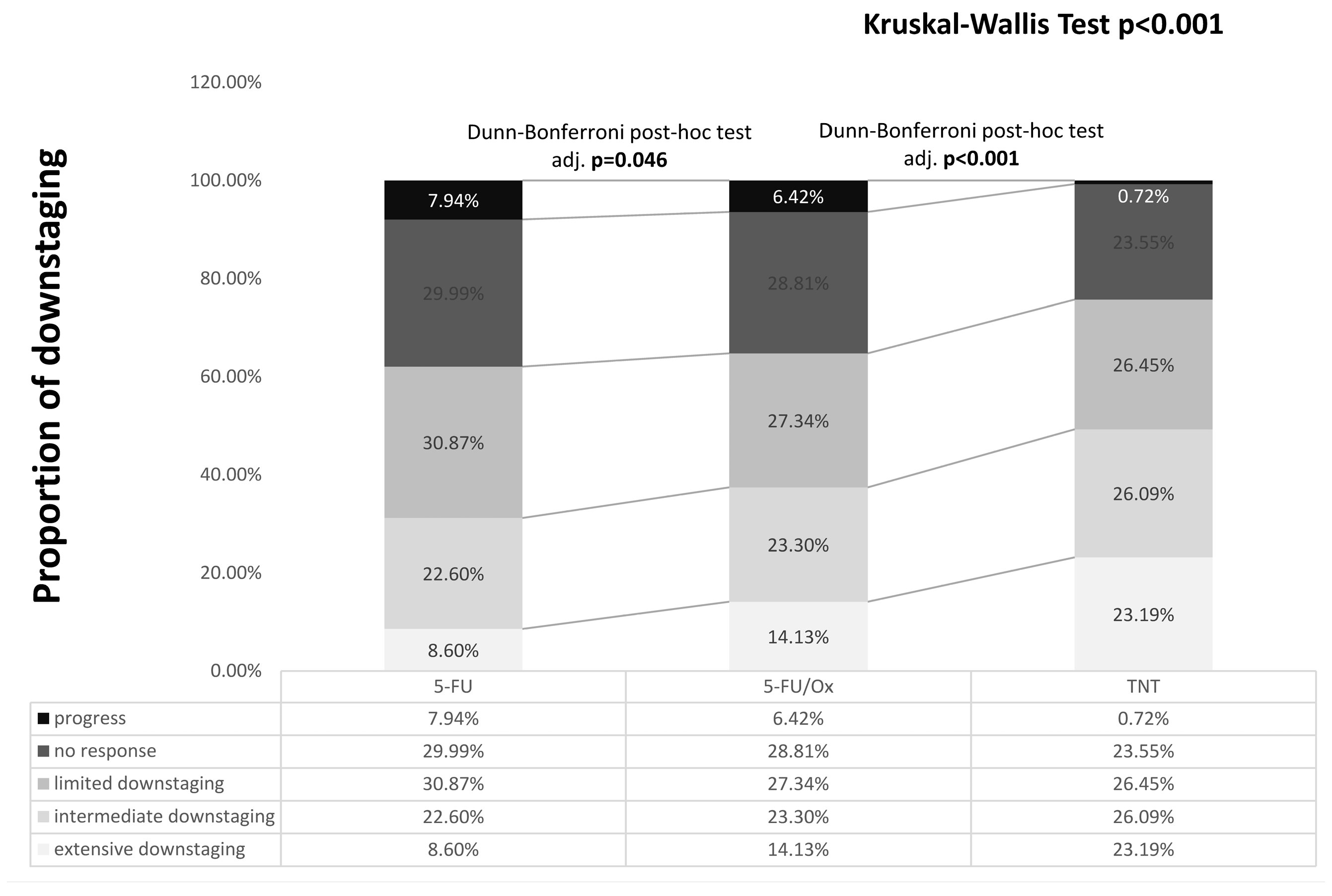
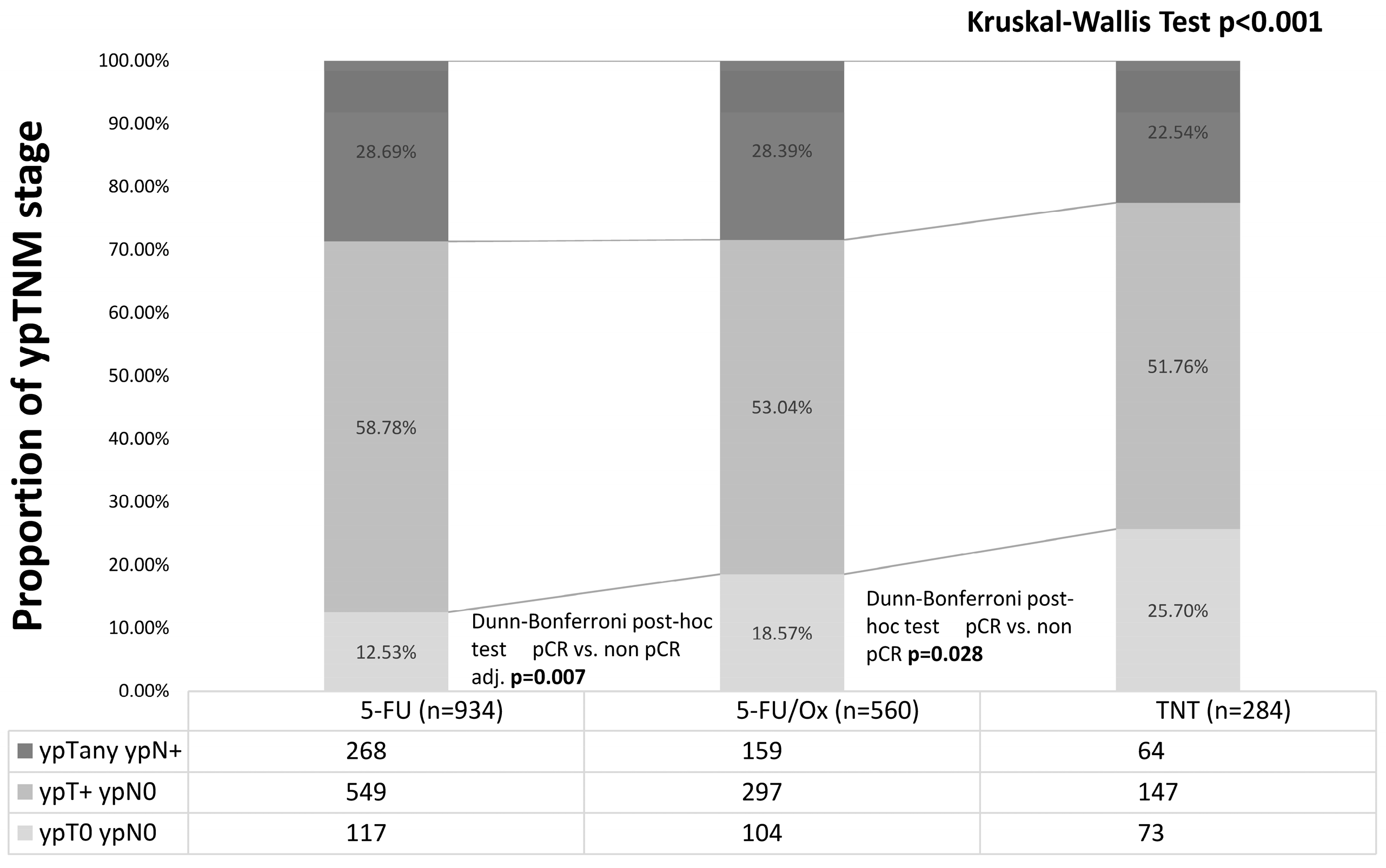
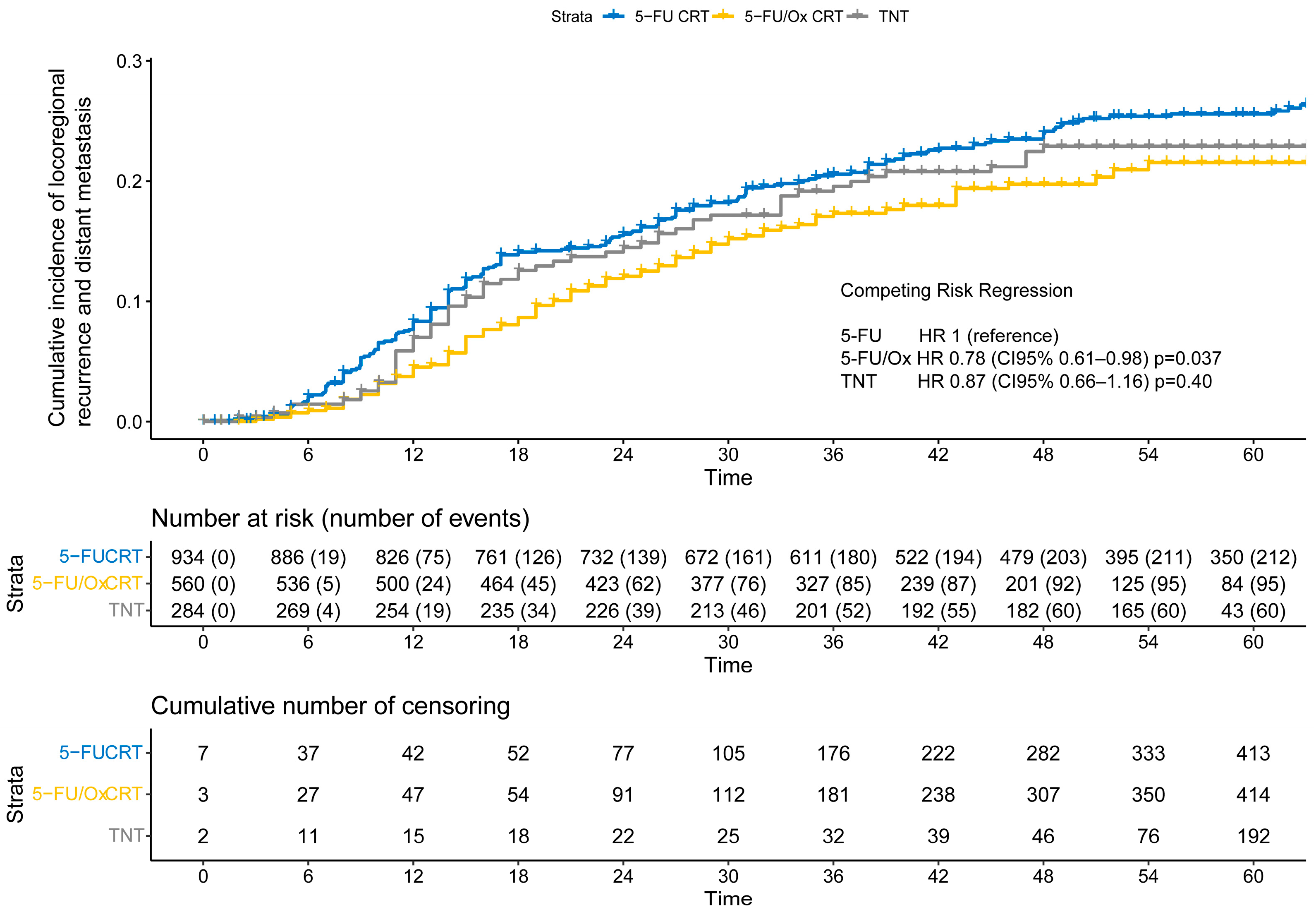
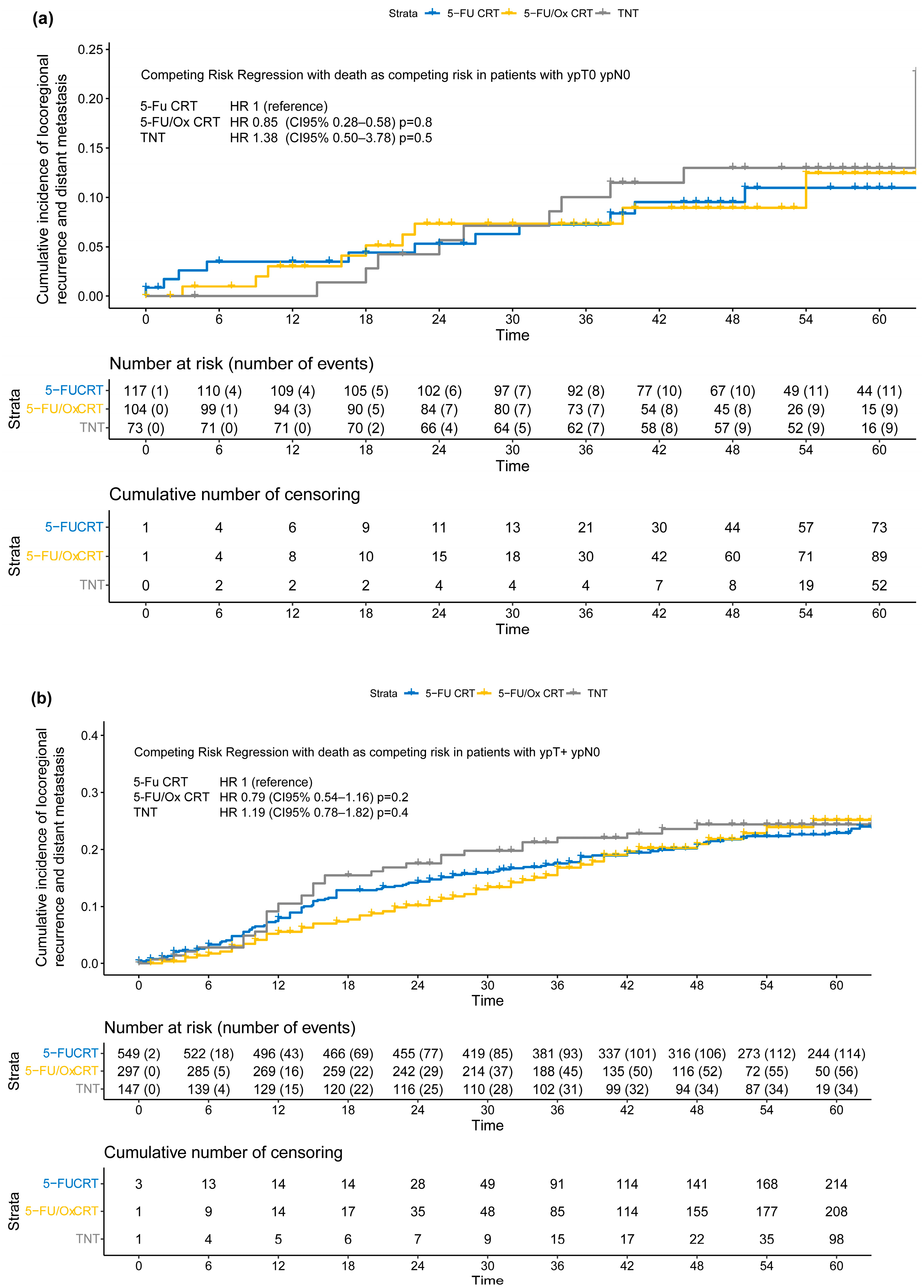
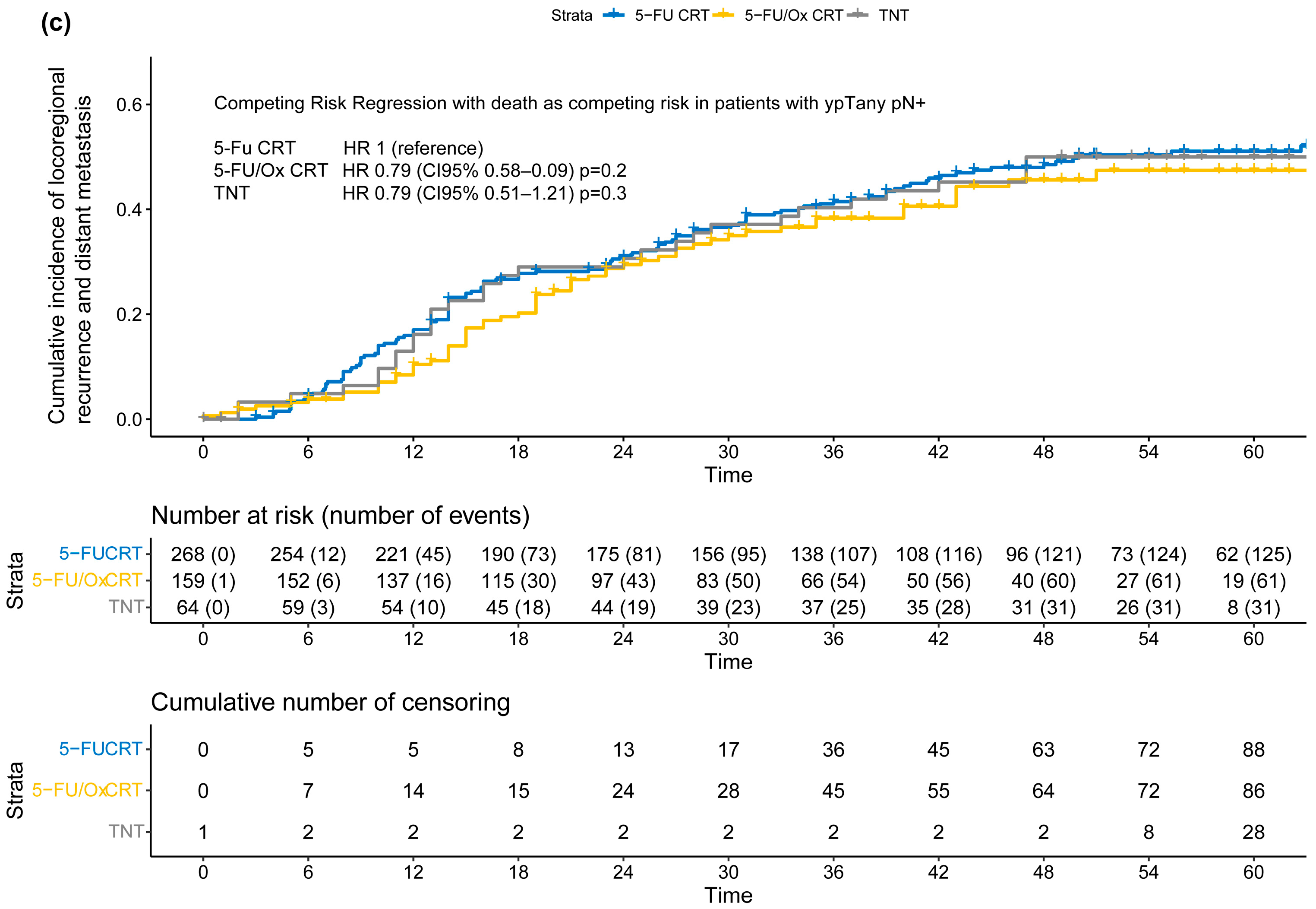
| Characteristics | Study Cohort | 5-FU CRT n = 934 | 5-FU/Ox CRT n = 560 | TNT n = 284 | p-Value |
|---|---|---|---|---|---|
| Gender | |||||
| Male | 1254 (70.5%) | 660 (70.7%) | 401 (71.6%) | 193 (68.0%) | |
| Female | 524 (29.5%) | 274 (29.3%) | 159 (28.4%) | 91 (32.0%) | 0.542 * |
| Age | |||||
| Median age | 1778 (100%) | 62 years | 64 years | 61 years | 0.084 ** |
| Tumor localisation | |||||
| Low <0 cm to 5 cm of the anal verge | 692 (39.6%) | 351 (38.4%) | 224 (40.5%) | 117 (41.9%) | |
| Intermediate 5 cm to 10 cm of the anal verge | 885 (50.7%) | 469 (51.3%) | 278 (50.3%) | 138 (49.5%) | |
| High >10 cm of the anal verge | 170 (9.7%) | 95 (10.4%) | 51 (9.2%) | 24 (8.6%) | 0.750 * |
| Missing | 31 | 19 | 7 | 5 | |
| cT | |||||
| cT2 | 115 (6.6%) | 42 (4.9%) | 19 (3.4%) | 10 (3.5%) | |
| cT3 | 1501 (85.9%) | 760 (88.5%) | 507 (90.5%) | 234 (82.4%) | |
| cT4 | 130 (7.4%) | 57 (6.6%) | 33 (5.9%) | 40 (14.1%) | <0.001 * |
| Missing | 75 | 75 | 1 | 0 | |
| cN | |||||
| cN0 | 464 (26.9%) | 302 (33.3%) | 137 (25.1%) | 25 (9.1%) | |
| cN+ | 1264 (73.1%) | 605 (66.7) | 408 (74.9%) | 251 (90.9%) | <0.001 * |
| Missing | 50 | 27 | 15 | 8 | |
| Grading | |||||
| G1 | 77 (46.4%) | 32 (3.8%) | 28 (5.3%) | 17 (6.6%) | |
| G2 | 1430 (86.1%) | 721 (85.3%) | 454 (85.8%) | 255 (87.5%) | |
| G3 | 154 (92.7%) | 92 (10.9%) | 47 (8.9%) | 15 (5.8%) | 0.05 |
| Missing | 148 | 89 | 31 | 27 | |
| Type of surgery | |||||
| Anterior/deep anterior resection | 1169 (66.0%) | 620 (66.4%) | 367 (65.5%) | 182 (65.9%) | |
| Intersphincteric resection | 105 (5.9%) | 63 (6.7%) | 30 (5.4%) | 12 (4.3%) | |
| Extirpation | 445 (25.1%) | 225 (24.1%) | 142 (25.4%) | 78 (28.3%) | |
| Other | 51 (2.9%) | 26 (2.8%) | 21 (3.8%) | 4 (1.4%) | 0.276 |
| No surgery | 8 | 0 | 0 | 8 | |
| Missing | 0 | 0 | 0 | 0 | |
| TME | |||||
| Complete | 1405 (84.4%) | 745 (86.7%) | 430 (80.7%) | 230 (84.6%) | |
| No complete | 259 (15.6%) | 114 (13.3%) | 103 (19.3%) | 42 (15.4%) | 0.01 |
| Missing | 114 | 75 | 27 | 12 | |
| ypT | |||||
| ypT0 | 311 (17.5%) | 123 (13.2%) | 113 (20.2%) | 75 (26.4%) | |
| ypT1 | 120 (6.7%) | 58 (6.2%) | 38 (6.8%) | 24 (8.5%) | |
| ypT2 | 519 (29.2%) | 292 (31.3%) | 157 (28.0%) | 70 (24.6%) | |
| ypT3 | 776 (43.6%) | 433 (46.4%) | 238 (42.5%) | 105 (37.0%) | |
| ypT4 | 52 (2.9%) | 28 (3.0%) | 14 (2.5%) | 10 (3.5%) | <0.001 |
| Missing | 0 | 0 | 0 | 0 | |
| ypN | |||||
| ypN0 | 1287 (72.4%) | 666 (71.3%) | 401 (71.6%) | 220 (77.5%) | |
| ypN+ | 491 (27.6%) | 268 (28.7%) | 159 (28.4%) | 64 (22.5%) | 0.016 |
| Missing | 0 | 0 | 0 | 0 | |
| ypL | |||||
| ypL negative | 1545 (87.0%) | 778 (83.4%) | 505 (90.2%) | 262 (92.9%) | |
| ypL positive | 230 (13.0%) | 155 (16.6%) | 55 (9.8%) | 20 (7.1%) | <0.001 |
| Missing | 1 | 1 | 0 | 0 | |
| ypV | |||||
| ypV negative | 1686 (94.4%) | 877 (94.7%) | 534 (95.4%) | 275 (97.5%) | |
| ypV positive | 82 (4.6%) | 49 (5.3%) | 26 (4.6%) | 7 (2.5%) | 0.145 |
| Missing | 10 | 8 | 0 | 2 | |
| Resection status | |||||
| R0 | 1714 (98.1%) | 913 (98.8%) | 543 (97.8%) | 258 (95.9%) | |
| R1 ° | 34 (1.9%) | 11 (1.2%) | 12 (2.2%) | 11 (4.1%) | 0.009 |
| Missing | 403 | 10 | 5 | 15 | |
| TRG | |||||
| TRG 0/1 | 300 (17.9%) | 188 (20.6%) | 76 (13.9%) | 36 (12.9%) | |
| TRG 2/3 | 1131 (64.0%) | 604 (66.3%) | 357 (65.4%) | 170 (61.2%) | |
| TRG 4 | 304 (18.1%) | 119 (13.1%) | 113 (20.7%) | 72 (25.9%) | <0.001 |
| Missing | 43 | 23 | 14 | 6 |
| Competing Risk Regression Model | Treatment Failure | ||
|---|---|---|---|
| HR | CI 95% | p-Value | |
| No response/progress | Reference | ||
| Limited downstaging | 0.37 | (0.26–0.51) | <0.001 |
| Intermediate downstaging | 0.17 | (0.11–0.28) | <0.001 |
| Extensive downstaging | 0.19 | (0.09–0.39 | <0.001 |
| 5-FU CRT | Reference | ||
| 5-FU/Ox CRT | 0.81 | (0.60–1.09) | 0.16 |
| TNT | 1.01 | (0.68–1.52) | 0.95 |
| Interaction terms | |||
| Limited downstaging × 5-FU/Ox CRT | 1.23 | (0.69–2.19) | 0.48 |
| Limited downstaging × TNT | 0.73 | (0.28–1.91) | 0.52 |
| Intermediate downstaging × 5-FU/Ox CRT | 0.80 | (0.23–2.81) | 0.73 |
| Intermediate downstaging × TNT | 1.29 | (0.62–2.65) | 0.50 |
| Extensive downstaging × 5-FU/Ox CRT | 1.10 | (0.42–2.85) | 0.85 |
| Extensive downstaging × TNT | 1.15 | (0.38–3.46) | 0.81 |
| Competing Risk Regression Model | Treatment Failure | ||
|---|---|---|---|
| HR | CI 95% | p-Value | |
| TRG 4 | Reference | ||
| TRG 2/3 | 3.71 | (1.84–7.49) | <0.001 |
| TRG 0/1 | 6.48 | (3.14–13.4) | <0.001 |
| 5-FU CRT | Reference | ||
| 5-FU/Ox CRT | 1.03 | (0.38–2.82) | 0.95 |
| TNT | 1.60 | (0.61–4.21) | 0.34 |
| Interaction terms | |||
| TRG 2/3 × 5-FU/Ox CRT | 0.85 | (0.30–4.21) | 0.76 |
| TRG 2/3 × TNT | 0.63 | (0.20–1.95) | 0.42 |
| TRG 4 × 5-FU/Ox CRT | 0.67 | (0.24–1.86) | 0.44 |
| TRG 4 × TNT | 0.41 | (0.12–1.35) | 0.14 |
Disclaimer/Publisher’s Note: The statements, opinions and data contained in all publications are solely those of the individual author(s) and contributor(s) and not of MDPI and/or the editor(s). MDPI and/or the editor(s) disclaim responsibility for any injury to people or property resulting from any ideas, methods, instructions or products referred to in the content. |
© 2024 by the authors. Licensee MDPI, Basel, Switzerland. This article is an open access article distributed under the terms and conditions of the Creative Commons Attribution (CC BY) license (https://creativecommons.org/licenses/by/4.0/).
Share and Cite
Diefenhardt, M.; Martin, D.; Fleischmann, M.; Hofheinz, R.-D.; Ghadimi, M.; Rödel, C.; Fokas, E. Tumor Response and Its Impact on Treatment Failure in Rectal Cancer: Does Intensity of Neoadjuvant Treatment Matter? Cancers 2024, 16, 3673. https://doi.org/10.3390/cancers16213673
Diefenhardt M, Martin D, Fleischmann M, Hofheinz R-D, Ghadimi M, Rödel C, Fokas E. Tumor Response and Its Impact on Treatment Failure in Rectal Cancer: Does Intensity of Neoadjuvant Treatment Matter? Cancers. 2024; 16(21):3673. https://doi.org/10.3390/cancers16213673
Chicago/Turabian StyleDiefenhardt, Markus, Daniel Martin, Maximilian Fleischmann, Ralf-Dieter Hofheinz, Michael Ghadimi, Claus Rödel, and Emmanouil Fokas. 2024. "Tumor Response and Its Impact on Treatment Failure in Rectal Cancer: Does Intensity of Neoadjuvant Treatment Matter?" Cancers 16, no. 21: 3673. https://doi.org/10.3390/cancers16213673
APA StyleDiefenhardt, M., Martin, D., Fleischmann, M., Hofheinz, R.-D., Ghadimi, M., Rödel, C., & Fokas, E. (2024). Tumor Response and Its Impact on Treatment Failure in Rectal Cancer: Does Intensity of Neoadjuvant Treatment Matter? Cancers, 16(21), 3673. https://doi.org/10.3390/cancers16213673






